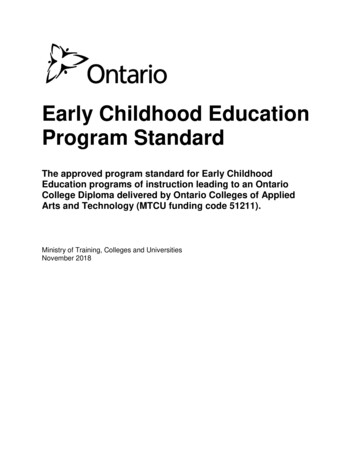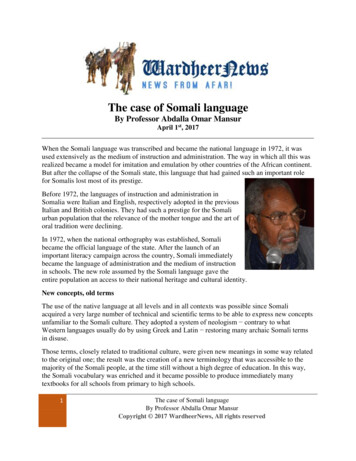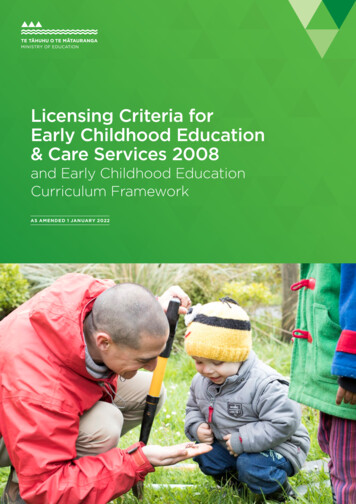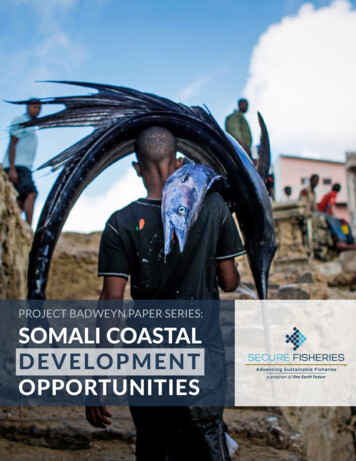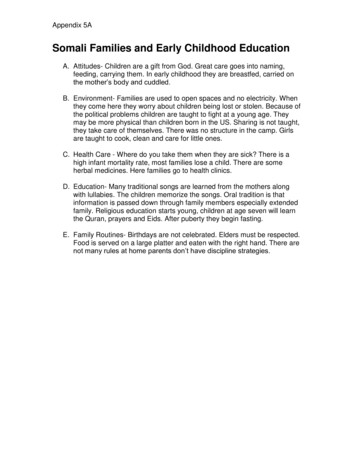
Transcription
Appendix 5ASomali Families and Early Childhood EducationA. Attitudes- Children are a gift from God. Great care goes into naming,feeding, carrying them. In early childhood they are breastfed, carried onthe mother’s body and cuddled.B. Environment- Families are used to open spaces and no electricity. Whenthey come here they worry about children being lost or stolen. Because ofthe political problems children are taught to fight at a young age. Theymay be more physical than children born in the US. Sharing is not taught,they take care of themselves. There was no structure in the camp. Girlsare taught to cook, clean and care for little ones.C. Health Care - Where do you take them when they are sick? There is ahigh infant mortality rate, most families lose a child. There are someherbal medicines. Here families go to health clinics.D. Education- Many traditional songs are learned from the mothers alongwith lullabies. The children memorize the songs. Oral tradition is thatinformation is passed down through family members especially extendedfamily. Religious education starts young, children at age seven will learnthe Quran, prayers and Eids. After puberty they begin fasting.E. Family Routines- Birthdays are not celebrated. Elders must be respected.Food is served on a large platter and eaten with the right hand. There arenot many rules at home parents don’t have discipline strategies.
Appendix 5BVital Components of Somali Tradition – For American School StaffBy: Hassan Ali MohamudI. INTRODUCTIONThe origin of Somali culture is from Islamic tradition and from the ancestors. Ifthe culture is coming from the Islamic tradition it is unchangeable especiallywhen it is related to the faith. If the culture, however, is related to the ancestor‟scustoms, and is harmful to the life of person this tradition is changeable. In thisessay, I will be discussing how Somali students can be successful students in theAmerican education system without rejecting their culture. In my discussion, Iwill try to build a home that can peacefully meet and live in both the Americaneducation system and Somali culture. I am going to talk about traditions thatcreate barriers that can affect the life of the Somali students. In other words,traditions, which may have impact on the success of Somali students in this newenvironment. In my essay, you will read that most of the elements of Somalicultures do. All my discussion will be based on my knowledge and experience ofboth Somali culture and the American education system. In my essay, I will alsoaddress the meaning of dress, food, prayer, greeting in Somali culture and otherimportant elements of the tradition. I will talk about how Somali students see theAmerican schools. I believe understanding the Somali culture, related to thebehavior of Somali students will be very helpful tools to the American school staffwho want to help Somali students reach their educational goal.II. DRESS IN SOMALI TRADITIONIn Somali culture, the form of dress is important for both women and men. Thisculture about how to dress has roots from Islamic religion that Somalis believe in.For example, women should wear HIJAB, which is a dress that covers her body,except their hands and faces according to the Islamic tradition. Men should alsowear a dress that covers between waist and knees according to the tradition.They should both start dressing this way when they are seven or nine years old.Somali parents teach their kids how to dress before they reach the age ofmaturity or puberty. Based on these beliefs, Somali families have the followingexpectations from the American schools:a) The schools will separate the girls from the boys when they have mixed orbody-touch activities such as swimming class.b) The schools will allow the Somali girls to dress in uniforms that reflect theirculture if the school has uniforms.c) The schools will give options to the students, especially girls, about any activityrelated to dress, for example, playing baseball or going to the school gym withsports dress. This will not be obligatory for the girls who do not want to do it.1
Appendix 5Bd) The schools will consult with student‟s parent regarding any conflict related todress.The families have a high expectation from the American schools especially withthings relating to the culture and religion. Somali parents believe that the schoolswill consult them about their children‟s activities and education in schools.III. FOOD IN SOMALI TRADITIONLike the dress, food is important in Somali culture and religion. Because of theIslamic tradition, it is prohibited to eat any food related to pork and alcohol.Therefore, parents expect the school to listen to the following advice.a) The school should send home the school‟s menu for the month.b) The school should know basic information about student‟s cultural food inorder to serve them better.c) The school should give out a Somali translated menu, that can help studentsunderstand the meaning of some American food.For example, the meaning of „hot dog‟ should be translated to the Somalilanguage. One time, in our school, we had Somali student who wouldn‟t haveher lunch in the school for almost one week. When a teacher asked the studentwhy she didn‟t eat the school lunch, she answered that, “American students eatdogs and I don‟t!” Then, the teacher called me for help. I found out that thestudent‟s brother read on the menu, “hot dog,” and told his sister not to eat theschool lunch because American students eat dogs. This misunderstanding andethnocentrism from both cultures could cause students and their families to havemany concerns about anything related to the school lunch. Therefore, it is goodto have a translated menu if it is possible.IV. PRAYERSLike other Muslims, Somalis pray five times every day wherever they are. Backhome, all schools have a place for prayer in order to help student‟s continue theireducation without interrupting their daily school program. Most Somali studentsand their parents have questions about where their children can pray and howthe American schools can meet the needs of their students related to prayer. Interms of prayer, the following are the expectations of the Somali families inAmerica:a) Their children will have a room for prayer in schools.b) Their children will be allowed to go to the Friday prayer or will have groupFriday prayer in schools.c) The schools will have resources or basic information about prayer in Islam,school year-prayer-schedule and how it is different from other faith‟s prayers.2
Appendix 5Bd) The schools should take seriously any advice about prayer coming fromstudents and their parents. Because of the culture clash about the time and theplace of prayer, students will not concentrate their study. Instead, they thinkabout solving the problems of the new culture.V. APPULTION AS REQUIREMENT OF THE PRAYERThe students should make appultion before they pray. Appultion is to wash theface, arms, and legs in the bathroom. This tradition is new in the Americanculture and it may create a clash between two cultures. The American studentmay take offence when he uses the sink to wash his face and Somali studentuses it to wash his legs. The solution is that Somali students should have theirappultion at home before they come to school. If the appultion is invalidatedduring the school hours, the school should give a place for appultion to Somalistudents or explain to American students why the Somalis are doing this. Inaddition to that, students should clear their private parts with water before theygo to the process of the appultion. It is the student‟s responsibilities to clean upthe bathroom floor before and after the appultion. Finally, the schools andfamilies should have agreements and guidelines about the prayer issues. Then,the agreed guidelines will help reduce the cultural clashes in the school site.VI. RAMADAN IN SOLMALI TRADITIONRamadan is the most important month for the Moslem people around the world.It is the month when the Moslem holy book, the Quran, was revealed. Therefore,all Moslems fast a whole month to follow the guidance of the Quran. In thesecond chapter of the Quran, Allah (God) prescribed fasting for Ramadan to allMoslems. Ramadan is the ninth month of the Islamic calendar based on thelunar system. This month is observed as sacred with fasting practiced daily fromdawn to sunset. No eating or drinking is permitted during those hours. Muslimsfast twenty-nine or thirty days depending on the moon sight. Like all Moslems,Somali people fast and celebrate this holy month full of inspiration. Somalisprepare many things before this month starts. For example, they beautify theirhomes with flowers and different lights. They also buy different foods such asmore diets for breakfast. Not only adults but also children who have reachedpuberty practice fasting in this month. Unlike the adults, the children who havenot reached puberty can fast half day if they can‟t finish their full day. However,once puberty starts the young adult should fast all month in the same manner asadults do from dawn to sunset.Afur is Somali term for breakfast and it is an important time that all familymembers sit and eat together to break the fast. This happens at sunset everyday of Ramadan. Children are very happy because they eat with their family andplay around with other kids. Kids like to play outside with other kids while theirfamilies are breaking the fast although the weather in the USA has its own count.Somalis eat special food at breakfast time such as dates, Bur and Sambusi,3
Appendix 5Bwhich is Somali food. After the breakfast people go to the mosque or prayerplace for Tarawih. Tarawih is the prayer that takes place every night ofRamadan after the breakfast. The tarawih prayer contains at least eleven rakat(bowing down for worship), which also could be physical exercise after the bigfeast. Tarawih prayer isn‟t obligatory but it‟s recommended. All family memberscan participate in this Tarawih gathering regardless of their age or gender. Thereis also Suhur food, which is the food that Somalis eat between midnight andclose to dawn. Suhur is another important time to eat food in order to fast nextmorning. Back home, in Somalia, there was a system that helps Somalis wakeup and eat their Suhur. This Islamic announcement is called Adan, which is thesame as calling for prayer. In addition to that, in Somalia, Somalis use drums towake up people. Volunteers of the village do all those announcements.However, in the United States, Somalis use alarm clock for Suhur time. Somefamilies call each other by phone for Suhur time. Then all members of the familywake up and eat together again. At Suhur time, they usually eat a big meal suchas rice or corn. The Suhur may take one to two hours to finish eating andcleaning up. Suhur is also important for kids in order to keep them strong whilethey are in school during the day. Therefore, the American school system,especially food service department should know all this in order to know howmuch food they serve to their students during the month of Ramadan. Thisfasting will not affect the student‟s daily activities except the first two days. InSomalia, all Somali students went to schools while they were fasting and they didfine. During Ramadan, Como High School is a good example to follow becausethey have the following activities: a) a room for students who fast; b) anannouncement the beginning and the end of Ramadan; and, c) a description ofRamadan and its meaning in its school newsletter.VII. SOMALI TRADITIONAL HOLIDAYAt the end of Ramadan, Somalis celebrate the first holiday. They come togetherat a big place where they can hold a prayer and big festival. This normallyhappens the next morning after the last day of Ramadan. This big holiday isexpected on 29th or 30th of January 1998. It depends on the moon sight again. Itis one of the biggest holidays for Moslems. Somalis take a day off from their jobsand schools for Id celebration. It is for three days of eating and drinking all typesof traditional foods. Those days, every member of the family should wear newand beautiful clothing and feel happy for their completion of Ramadan. Familiesand friends bring different types of gifts and visit each other. They say to eachother “ID Mubarak” which means have a happy and blessed holiday. Parentsbring their children to children‟s places and buy toys for them. During thesedays, even poor people will be happy and wear new and beautiful clothing.During the month of Ramadan each family member should pay Fitri, which is anamount of seven dollars to the poor families. So, poor families can also havehappy holiday after Ramadan.4
Appendix 5BThe second holiday is the 10th day of the last month of the Islamic lunar calendar.Somalis have a big feast in these holidays. The Somali students do not go toschool these days because they are special days for them. Schools should beaware of these days in order to help Somali students have happy holidays.VIII. TRADITIONAL GREETINGSEvery culture has its own way of greeting. Like other Muslims who practiceIslam, men don„t shake a women‟s hand for greeting except if they are spouses.The Somali women don‟t shake men‟s hands either. Therefore, some studentsand their parents have difficulties when they meet Americans who don‟t know thistradition. They can‟t explain this matter because of language barriers. So, theyprefer not to come to any meeting. Again, this culture clash could be avoided ifeach cultural group educates the other group in order to have a platform that canmeet both cultures in positive way.IX. FEMALE CIRCUMCISIONSomali girls go through the process of female circumcision after they are born.This custom came originally from Egypt and it is one of the bad sides of Somalicustom. After 1980, the old government tried to outlaw this practice but peoplewere still practicing it underground. In short, this practice means to removeclitoris and surrounding part of girl‟s private parts. This practice doesn‟t relate tothe Islamic tradition at all. Now in many places, many Somali families fightagainst this practice. This practice has impact on the life of Somali girlsespecially the period time. Not only do they miss classes but also they becomesick about seven days in every month. Therefore, schools should consider thesituation of circumcised girls.X. PETS AND SOMALISIn Islamic tradition, Muslims are prohibited to touch the saliva of dogs. Once theperson‟s hand touches the saliva of a dog, he or she should wash his or her handseven times before they pray. Although one can touch the body of dog, Somalisdo not even like to be close to dogs as custom. Somali people may escape fromdogs in order to protect their appultion for prayer, otherwise it is invalidated.They avoid dogs as much as possible.IX. THE SOMALI STUDENTS AND HOW THEY SEE THE AMERICANEDUCATION SYSTEMFirst of all let me divide Somali students into two groups:A) Students who knew and experienced the school system in their countryB) Students who are new to the education system.5
Appendix 5BThe first group has positive eyes for the American schools although they havelanguage problems. For this group, the success of their education depends onhow far the school programs meet their needs as new Americans. This groupwill have fewer problems in the American school system compared to the othergroup except for the cultural problems, which I mentioned above.The second group will have more problems coping with the American educationsystem because of the following reasons.1. They have never been in any school system before.2. They have never spoken any language other than their native language.3. In their daily life, most of them have never lived in big and sophisticated citieslike Minneapolis and St. Paul.4. They have never experienced a culture other than their home culture.These four and other reasons will cause group “B” to have a hard time adjustingto the American education system. The question is whether they can survive intheir new home. How can they get step-by-step help until they cope with the neweducation system? At first, this group will have a negative impression of theAmerican education system. They think that everything is against them. Forexample, one day I met a Somali student in the TESOL office, who had just cometo America. When I finished her school processing, she told me that she wishedshe could go back to the refugee camps. When I asked her why, she told methat nothing is helpful in this new life and everything is against her. She said,“Why do they ask me questions in English when I don‟t even know the differencebetween pen and pencil in Somali language?”. This is a classic example thatgives an idea about their feelings as new students in American schools. InMinneapolis and St. Paul public schools there are very large number of TYPE Bstudents. Hence in my opinion, this group should get an American educationprogram that fits their needs in order to help them have success in theireducation.In conclusion, these components which relate to the Somali tradition and theSomali student‟s background will help the staff of the American schools get asuitable successful education system for the new Americans.6
Appendix 5CTHE NAMES OF SOMALI PEOPLEMost Somali names have a certain meaning. Some names have Arabic originsand others have Cushtik or Somali origins. Here are some examples:CUSHTIK NAMES:GIRL’S AdeyHaweyaHo danSa galUbahMEANINGFair-skinnedThe elevated oneWell-to-doMorning starFlowerBOY’S porter of rightDoer of goodThe victoriousThe hukriMEANINGLong livingWeaned earlySuccessfulNight (long dark hair)ThankfulARABIC NAMES:GIRL’S NAMECaishaFaadumaFawziyaLeylShukriBOY’S NGThe highThe slave of GodThe long livingThe lastingHandsome
Appendix 5DUSEFUL SOMALI EXPRESSIONS WITH ENGLISH TRANSLATIONSOMALIENGLISHADIGA KALIYA SAMEEMAHADSANIDSHAQO FIICAN (shako fi an)ISKU DAY MAR KALEMAYAI KAALMEE, FADLANI SOO FIIRIFIIRITARTIIBSOSOCO (so o’)HADDASUGJOOGSOFARIISOISKA WARANSUBAX WANAAGSAN (subah Wanagsan)FADLANDO IT YOURSELFTHANK YOUGOOD WORKTRY AGAINNOHELP ME PLEASEWATCH MELOOKSLOW DOWNWALKNOWWAITSTOPSIT DOWNHELLOGOOD MORNINGPLEASE
Appendix 5ESignificance of Ramadan[Type text]
Disabilities in theSomali community
Personal story #1:Sharif Farah Sharif will share his personal experiencein US, including barriers and successes
Q: What are common health beliefsand practices regarding disability inthe Somali community? Disability is God’s will, therefore,unquestionable. Disability is generally perceived aspermanent, non-preventable anduntreatable. Disability is then accepted without theneed for treatment.
Q: To what extent do religiousbeliefs influence this? Role of IslamStigmaName calling
Q: What are attitudes towardmental health and utilizingresources among Somalis? Perception: Mind, body, and spirit areseen as a whole and undivided.Mental Illness [MI] is not easily acceptedand is denied as long as possible.MI person is considered violent, such astaking off one's clothes in public, beatingor screaming at someone else randomlyand unpredictable behavior.
Expressions of Mental Illness Buufis: Mostly common used term. Personin this stage wonders around, sleepless,unable to eat, talking tothemselves literally means, inflating aballoon to the point of bursting! Murug/Welwel. An everyday sadness,stress, disappointment. Gini or Jinni: supernatural beings or spiritsthat exert influence over human beings.
Causes of Mental Illness Spirit possession: Spirits reside within theindividual.Moral transgression: Result of a divine will.Evil Eye: Caused by other people. Less fortunateperson may evil eye a healthy and wealthyperson.Curses by ill treated or disregarded parents arethe most dreadful ones.Witchcraft: throwing spell on someoneintentionally.Gini/Jinn: Supernatural spirits or ghostspossessing someone.
Treatment of Mental Illness Spiritual Healing: Sheik or Imam recitesthe Koran on MI person.Traditional healing: Animal sacrifices,spirit experts diagnose the patient andconduct their rituals through dances,music, songs, herbs, etc.Medication: when all other options areexhausted.Incarceration: Last resort. When behavioris threatening to self and others.
Barriers to Treatment Stigma and Shame: Fear of labeling &gossip. People are named after theirphysical defects.Mistrust & Fear: Providers, Psychotropicmedications & misdiagnosis.Lack of Information: No awareness ofneeds & possibility of treatment.
Beliefs regarding palliative care,death and dying in relation tohealth and health care Fatalism Imams or Islamic elders are called uponto recite the Koran on the dying. Imams remind the fatally ill toremember that there is only one God. Death is considered God’s will.
Q: What role do the clans andsubclans play in receiving care andusing resources, specifically Somalicommunity resources?
Personal story #2 - Child Disabled children are always withtheir parents.Only parents make the healthdecisions for disabled children.Parents don’t mention their disabledchildren unless with a physician.
What are the gaps in resources,including healthcare, in theSomali community? Gaps: Cost/Access Language Transportation Understanding of Western medicalmodel Etc.
The Disabled ImmigrantAssociation [DIA]
The Disabled ImmigrantAssociation Mission: To improve thelives of immigrant people withdisabilities in the Twin Cities.DIA supports disabled immigrants and theircareer development through the provision ofinformation, referrals, education regarding rights,peer support, and guidance in navigating throughcomplex barriers to receiving support servicesand jobs.DIA is dedicated to empowering immigrants withsocial, mental, and physical disabilities.
DIA Goals Improve access to social services, benefits,healthcare and jobs.Address cultural biases both in the mainstreamcultures and in African culturesBuild the self esteem and sense of empowerment ofour constituents.Help mainstream systems, e.g. healthcare,employment, and social services better understandthe needs of this population.
DIA Services Information and referralInformal case managementPeer supportsOutreach
Tips on developing cultural awareness Become aware of our own culturalbackground. Become aware that there are no wrong orright cultural beliefs. Establish personalized contact withfamilies and their children. Learn about the people that you serve.[like today! ]
Tips (cont) Educate the community’s culturally diverseleaders.Develop and use vocabulary of greetings andkey phrases in patient’s primary language: Iskawaaran hello/greetingNabadeey have a good dayMahad senid thank youBe sensitive to patient’s cultural perception ofdisability.
Mahad senid [thank you]!Questions?
Appendix 5GAn Asian View of Cultural Differences(With Thanks to Dr. Mai Van Trang)We live in time.We are always at rest.We are passive.We like to contemplate.We accept the world as it is.We live in peace with nature.Religion is our first love.We delight to think about themeaning of life.We believe in the freedom of silence.We lapse into meditation.We marry first, then love.Our marriage is the beginning ofa love affair.Marriage is an indissoluble bond.Our love is mute.We try to conceal love from the world.Self-denial is a secret to our success.We are taught from the cradle to wantless and less.We glorify austerity and renunciation.Poverty to us is a badge of spiritualelevation.In the sunset years of life, werenounce the world and preparefor the hereafter.You live in space.You are always on the move.You are aggressive.You like to act.You try change it according to your plan.You try to impose your will on her.Technology is your passion.You delight in physics.You believe in freedom of speech.You strive for articulation.You love first, then marry.Your marriage is the happy end of a romance.Marriage is a contract.Your love is vocal.You delight in showing it to others.Self-assertiveness is the key to your success.You are urged everyday to want more andmore.You emphasize gracious living and enjoyment.It is to you a sign of degradation.You retire to enjoy the fruits of your labor.
Appendix 5HSocial/Cultural CustomsSimilarities and Differences between Vietnamese, Cambodians, Hmong and LaoPrimarily based on table prepared by staffof the Indochinese Mental Health ProjectBureau of Research and TrainingPennsylvania Office of Mental Health April,1980VIETNAMESEEdited and Further Developed byTEAM ASSOCIATES1625 Eye Street, N.W Washington, D.C.20006Under U.S. Department of LaborContract No: 99-7-998-36-27 July, 1980Further edited to update some Hmongcharacteristics from information contributedby Dr. Yang, Dao, February 2002CAMBODIANHMONGLAOS1. The family is the basis of society,not the individual.SameSameSame2. Up to 3 or 4 generations livetogether in one home.SameSameSame3. Within the family, the wife dealswith all household matters. Thehusband deals with the outsideworld.SameSameSame4. The elderly (parents) aresupported by married orunmarried children until they die.SameSameSame5. Family name is placed first as anemphasis on the roots of aperson. Names are written in thisorder:e.g. Nguyen Van HaiFamily Name (first) – NguyenMiddle Name – VanGiven – HaiSame as VietnameseE.g. ChanSa MoiFamily Name (first) – ChanMiddle name – SaFirst Name – MoiNames are written in this order:For men: Lor Tong KhuFamily Name (first) – LorMidde Name (if any) – TongGiven name – KhuNames are written in this order:Given name, first then last name.Example: Thonedy SourivongFor women: Changh Sourivong.Given name: ChanhFamily name when marriedSourivongA. General
6. Family members cannot use thesame first name.SameSameSame7. Small families are nowencouragedParents are proud of a large familySameSameCAMBODIANHMONGLAOS8. Children live with their parentsuntil they get married. Men marrybetween the ages of 20 and 30.Women marry between the agesof 18 and 25Men marry between 20 and 30.Women marry form age 18 and up.Men marry between ages 15 and30. Women marry between ages14 and 18.Men marry between ages 18 and30. Women marry between 16 and22.9. As a tradition (not law) a marriagemust be approved by parentsfrom both sides. This is true forpersons of all ages.SameSameSame10. First cousins and their childrencannot marry each other up tothree generations.First cousins can get married to eachother, but an uncle or aunt cannotmarry a niece or a nephew.First cousins cannot marry eachother if they belong to the sameclan. However, the children of thebrother can marry those of thesister because they belong to thesame clan.First cousins can marry each other,and an uncle can marry a niecefrom a royal family.CAMBODIANHMONGLAOS11. The couple prefers to celebratetheir wedding at the home ofeither side, not at the church ortemple.Same, but only at bride’s house.Same as Cambodian.Same as Cambodian.12. Legally, women keep their ownnames after marriage. Formally,married women use theirhusband’s first name.Example:Husband’s name: Nguyen VanAfter marriage, a woman keeps herfirst name and adds her husband’slast name officially. Informally, shecan be called by either her first nameor husbands’ last name.Example:Same as VietnameseSame as Cambodian.VIETNAMESEB. MarriageVIETNAMESEExample:Husband’s Name: Lor Tong KhuWife’s Maiden Name: Her MyWife’s Married Name: Her My2
Husband’s Name: Chan Sa NoiWife’s Maiden name: Ek Sam Hang.Wife’s Married Name; Mrs. Chan SaOi.Wife’s Informal Name: Mrs. SamHangWife’s’ Informal Name: Mrs. LorTong Khu13. After marriage, the wife lives withher husbands’ family. Form thatday, she belongs to her husband’family.After marriage, the couple can livewith either the wife’s family or thehusband’s family.Same as Vietnamese.Usually after marriage, the couplelives with the wife’s family.14. Before 1959, Vietnamese mencould have more than one wife.Ranking in order of responsibility:First WifeSecond WifeThird WifeCambodian men can have severalwives, but written consent of the firstwife is compulsory. All other wives areconsidered to rank second. If the firstwife dies, one of the second wives,the oldest in marriage date or in age,can gain promotion to first rank.Hmong men can have severalwives and may not need to havethe first wife’s’ consent. Thehusband must treate the wivesequally. However, the first wife hasmore authority, is the one whoknows how to take care of thehusband and becomes the favoriteBefore 1945, same as Vietnamese.CAMBODIANHMONGLAOS15. No such custom (See Hmong)No such custom (See Hmong)For reasons of family solidarity, if aman dies, his younger brother (notolder) can marry his widow if sheconsents. Otherwise, she canmarry another man.No such custom (See Hmong)16. Divorce is legal but is notcommon. Both sides of the familyhandle family conflict.Divorce is legal and is encouragedwhen necessary, to avoid discordbetween families.Same as Vietnamese.Same as Vietnamese.Same as Vietnamese.Same as Vietnamese.Same as Vietnamese.HaiWifes’ Maiden Name: Le Thi BaVIETNAMESEC. Childbirth and Children17. In the countryside, Vietnameseprefer a mid-wife to deliver the3
child at home. She is often aidedby female relatives. (Men,unmarried women, girls, and thehusband are not to be present)18. (See Hmong) NO time limit forVietnamese woman, but usuallyshe stays in for one (1) week.She stays home for seven (7) days,but may wish to extend this periodfrom one to three (3) months.After delivery, a woman cannot goout to visit relatives or friends. Shemust stay inside the house for one(1) month.Same as Hmong.19.
education system and Somali culture. I am going to talk about traditions that create barriers that can affect the life of the Somali students. In other words, traditions, which may have impact on the success of Somali students in this new environment. In my essay, you will read that most of the elements of Somali cultures do.

